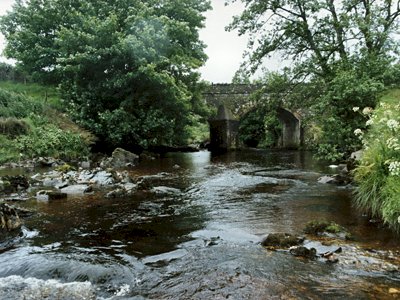Earth Science Conservation Review
| Knocknacarry Bridge, Cushendun | Antrim |
| Site Type: | Stream section |
| Site Status: | ESCR |
| Grid Reference: | D240327 |
| Google maps: | 55.12644,-6.05611 |
| Rocks | |
|---|---|
| Rock Age: | Precambrian (Dalradian) |
| Rock Name: | Cushendun Granite, Glendun Formation, Granite, Southern Highlands Group |
| Rock Type: | Psammite, Schist |
| Interest | |
| Minerals: | Cordierite |
Summary of site:
In the river bed on either side of Knocknacarry Bridge there are outcrops of an altered, gritty sandstone and siltstone belonging to the Glendun Formation. These rocks are the very last of the ancient Dalradian Supergroup of metamorphic rocks and they formed slightly less than 600 million years ago.
The rocks have an interesting mineralogy. During the process of regional metamorphism when they were heated and pressurised, the original minerals of the rock became unstable and new minerals developed from them. Here, prominent and well-formed crystals of cordierite have resulted from the process in the altered siltstone. They are best seen in a large detached block on the south side of the river 40 m upstream of the bridge.
These rocks also fall within the thermal aureole of the Cushendun granite that outcrops about 1 km north of the bridge. A thermal aureole is a zone of rock around a deep-seated magma chamber (filled with molten granite in this case) affected by its intense heat. The zone can also be influenced by the volatiles associated with the cooling magma which migrate through the surrounding rocks in the form of gases. This process is called pneumatolysis and here has created a network of veins, from a few millimetres to a few centimetres across, filled with quartz, feldspar and biotite, the essential minerals of granite.
600 million years ago, at the South Pole, the giant continent of Gondwana was rifting, pulling apart under the influence of diverging convection currents below the earth's crust. In the process, a new supercontinent, Laurentia, was shed and it was in the coastal marine basins of this landmass that these rocks were formed. The regional metamorphism was the result of a collision with an active volcanic arc about 130 million years later. The rocks buckled under these immense forces and massive folds, tens of kilometres across and over 100 km long, deformed the rocks The Knocknacarry Bridge succession is actually upside-down on the inverted, southern limb of the Altmore Anticline.
The Cushendun granite was formed after the rocks had been metamorphosed.
This is an important site giving good outcrops of the Glendun Formation in an area of otherwise poor rock exposure. Its mineralogy, particularly the pneumatolysis associated with the Cushendun granite, adds importantly to its status. Because the interest is confined to a relatively small area of the outcrop, the main threat is probably from over-sampling by student groups. It is recommended therefore that hammering is limited or prohibited.
The rocks have an interesting mineralogy. During the process of regional metamorphism when they were heated and pressurised, the original minerals of the rock became unstable and new minerals developed from them. Here, prominent and well-formed crystals of cordierite have resulted from the process in the altered siltstone. They are best seen in a large detached block on the south side of the river 40 m upstream of the bridge.
These rocks also fall within the thermal aureole of the Cushendun granite that outcrops about 1 km north of the bridge. A thermal aureole is a zone of rock around a deep-seated magma chamber (filled with molten granite in this case) affected by its intense heat. The zone can also be influenced by the volatiles associated with the cooling magma which migrate through the surrounding rocks in the form of gases. This process is called pneumatolysis and here has created a network of veins, from a few millimetres to a few centimetres across, filled with quartz, feldspar and biotite, the essential minerals of granite.
600 million years ago, at the South Pole, the giant continent of Gondwana was rifting, pulling apart under the influence of diverging convection currents below the earth's crust. In the process, a new supercontinent, Laurentia, was shed and it was in the coastal marine basins of this landmass that these rocks were formed. The regional metamorphism was the result of a collision with an active volcanic arc about 130 million years later. The rocks buckled under these immense forces and massive folds, tens of kilometres across and over 100 km long, deformed the rocks The Knocknacarry Bridge succession is actually upside-down on the inverted, southern limb of the Altmore Anticline.
The Cushendun granite was formed after the rocks had been metamorphosed.
This is an important site giving good outcrops of the Glendun Formation in an area of otherwise poor rock exposure. Its mineralogy, particularly the pneumatolysis associated with the Cushendun granite, adds importantly to its status. Because the interest is confined to a relatively small area of the outcrop, the main threat is probably from over-sampling by student groups. It is recommended therefore that hammering is limited or prohibited.
| Enlander, I., Dempster, M. & Doughty, P., 2025. Knocknacarry Bridge, Cushendun, County Antrim, site summary. [In] Earth Science Conservation Review. https://www.habitas.org.uk/escr/summary.php?item=163. Accessed on 2025-04-03 |
| Previous Site | Next Site |

